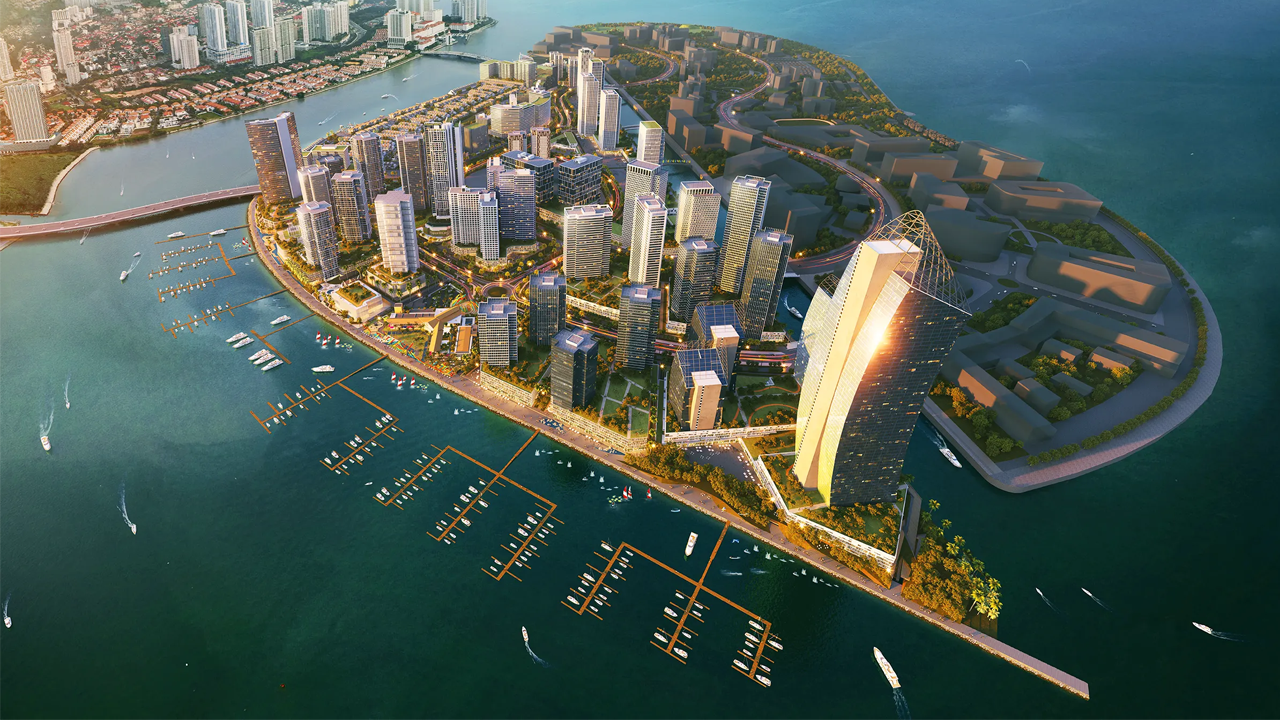Inside Real Madrid's $1BN Stadium Upgrade
- Youtube Views 3,710,796 VIDEO VIEWS
Video narrated by Fred Mills. This video and article contain paid promotion for Masterworks.
STADIUM redevelopments don’t get any bigger than this. The Santiago Bernabéu — home of Spanish football giants Real Madrid — is about to complete an epic transformation that’s like nothing we’ve seen before.
Plans to turn it into “the best stadium in the world” have finally become a reality after four years of construction, and the results are astonishing. What was already one of Europe’s most famous grounds has had the most incredible facelift.
And now it’s re-emerging as a modern, multipurpose, state-of-the-art arena that could soon have other big clubs, and cities, taking notes.
From a stunning, wraparound facade to a retractable roof and pitch, it’s the ultimate upgrade, which had to be done under heavy restrictions.
This is the story of how the Bernabéu was reborn, and why it could kick off a new era of stadium design.

Above: What the Estadio Santiago Bernabéu looked like before.
Ask any football fan to write a list of the world’s most iconic stadiums and this will certainly be on it — the Santiago Bernabéu in Spain.
Located just off the city’s main thoroughfare, it’s been the home of 14-time European champions Real Madrid since 1947. And it’s become one of the capital’s biggest landmarks.
Over the years there have been multiple refurbs, like the new roof that was put in ahead of the 1982 World Cup. Then, in 1992, four entrance towers were added and the stadium was changed to an all-seater.
But it was during Real’s General Assembly in 2011 that the club approved the Bernabéu’s most significant redevelopment yet.
At the meeting, Real’s President Florentino Perez invited architects to come up with a design that would meet its ambitious requirements.
These included “an avant-garde skin surrounding the stadium that would dramatically change its character, shading and protecting all seats from weather inclemencies.”
Crucially, it would need to be more than just a football ground. The club wanted a stadium that can host other sports, concerts and entertainment events, creating new revenue streams.
It was a similar story with London’s Tottenham Hotspur Stadium, designed by Populous. The company's EMEA managing director Christopher Lee was project director for that.
“Now that you can move 10-15,000 tons of equipment pretty quickly and pretty smoothly, the ability to reconfigure that building to virtually accommodate beyond, say, one night Real Madrid or Tottenham onto an NFL game the day after,” Lee said. “I think it’s super exciting.”

Above: The Tottenham Hotspur Stadium can be converted to host NFL games. Image courtesy of Edward Hill/Populous.
In the case of the Bernabéu, making it more profitable became a key priority for the club. A revamp could turn it into an even bigger attraction, helping to bring more tourists to the city.
Now, if you’re not familiar with these kinds of projects, a stadium upgrade will usually involve adding more seating, perhaps a new stand or a revamp of the amenities. The appearance might not change a great deal.
This one, though, sees the Bernabéu become virtually unrecognisable. Yes, the club that once gave us the Galácticos now has a stadium that looks truly out of this world.
And like its current team of superstars, all of this hasn’t come cheap. It’s expected to cost over USD $1BN — or around ten Jude Bellinghams — in total. That’s not far off what Tottenham spent on their stadium, which was completely new.
So, back to that design challenge. The winning bid from architects L35, GMB and Ribas&Ribas was announced in 2014. They proposed building an enveloping steel facade which images can be projected on to, along with a 360-degree video screen and a fixed roof that is fully closable.
There would also be new shops, entertainment and leisure facilities on the east and west sides, more green areas and public space, as well as a five-storey underground car park.
Offering more outside the stadium is another trend according to Populous — lead architect for a new project at Manchester’s Etihad Stadium aimed at boosting the fan experience.
"Increasingly, you see these buildings becoming part of a much bigger and wider sort of destination development,” Lee explained.
“Can we create environments, fan zones, shops, bars, restaurants, hotels that sometimes attach like at the Etihad, or sometimes just surround the buildings, to create these big bits of city that are leisure and hospitality destinations in a way?”

Above: The exterior of the stadium had to form a key part of the design for the new Bernabéu. Image courtesy of Real Madrid.
Overall, there’s been a lot happening at the Bernabéu, and much of the work had to be done with the building still in use.
So, what was the plan to actually tackle this monumental task, and how did the many construction teams involved manage to pull it off?
Work began by disassembling the old roof, which was done in stages. That left space for new seats to be put in at the top of the east side, increasing capacity from around 81,000 to 85,000.
To construct the new retractable roof, 800-tonne cranes were installed, allowing two gigantic steel trusses to be built from one end of the ground to the other. 176 metres in length, they were hoisted up and slotted together in ten segments that connected in the middle.
This meant constructing two new towers on the west side to support the new roof trusses and also provide better access and evacuation points. These have replaced the old B and C towers which have now made way for new public space.
Due to all that weight they’re having to carry, the towers had to be built with deep foundations. They’re now sitting on 26 wide-diameter piles that go down 36 metres, which are topped with a four-metre pile cap.
Also critical to the structure of the new roof are the four longitudinal megatrusses, which had to be lifted up from outside the ground before being gradually shifted towards the centre of the stadium (below).

Above: Over 33,000 tonnes of steel have been used on the refurbishment — the same as 120 Airbus A380s. Image courtesy of Real Madrid.
And at the peak of construction there were 800 workers on site here every day — even during the lockdowns of 2020. Only when Storm Filomena arrived in January 2021, bringing record snowfall, did work have to stop temporarily.
But perhaps the most impressive feature is one that fans don’t get to see. Not only is the roof retractable; the pitch is too.
Why? Because when there isn’t a match on and the venue is needed for something else that doesn’t require a grass pitch, it has to be disposed of quickly.
And like with the Tottenham Stadium that Lee worked on, having a cutting-edge system dedicated to this task has made a real difference.
"The ability to move really big bits of physical building, whether it's pitches or roofs or moving stands to reconfigure the building into another use where the physical environment is perfectly suited for that — I think that has a huge impact clearly [not just] on the built form, but the use of those buildings,” Lee said.
With the extraordinary new system at the Bernabéu, the pitch can be divided up into several pieces and sent underground to a sort of greenhouse, where it’s stored until the next home game.
Technology that controls aspects such as lighting, heating and irrigation ensures the turf is looked after even when it’s not in use.
Although the pitch is huge when it’s intact, there simply isn’t enough space below or around the stadium floor to put it away in one piece.
One big reason for this is a train line running directly beneath the venue. The other is the tight inner-city location, which in general has made an already challenging project even harder.

Above: The area where the pitch goes when it's not needed is more than just a storage space. Image courtesy of Real Madrid.
Now, there have been some unexpected difficulties. The upgrade was supposed to complete in 2022 but now it’s late 2023 and work is only just wrapping up.
This has been blamed on a combination of COVID-19 and the war in Ukraine, which led to material shortages and price rises. And yet, even though it’s taken longer than it was supposed to, it looks like it’ll be worth the wait.
The club doesn’t seem too concerned about the cost either. Thanks to its new versatility, the venue is predicted to bring in hundreds of millions of dollars in extra revenue every year.
Real Madrid wanted to do something spectacular with its new-look Santiago Bernabéu, and there’s little doubt they’ve scored a winning goal with this stunning upgrade.
Not only does it look absolutely jaw-dropping; this magnificent stadium is no longer just a place for Madridistas. It’s for everyone in the city to enjoy — yes, even Atletico Madrid fans, although that could take some getting used to.
These are changes that place the stadium right at the heart of the local community — another pattern that’s been emerging in recent years.
"If anything is shown over the last decade or two, it’s the amazing power of sports and sports infrastructure to positively impact the local environment, whether that's regeneration, whether it's opening up public realm, whether that's connecting bits of cities that weren't connected before. I think it’s really important,” Lee claimed.
It might have more European cups than anyone else but even so, calling Real Madrid the best football club in the world will always be up for debate. As for who has the best stadium, this one may have just found itself in a league of its own.
This video contains paid promotion for Masterworks. Skip the waitlist and invest in blue-chip art for the very first time by signing up here.
Additional footage and images courtesy of Real Madrid, Google Earth, Javier Caireta, Populous, Spurs TV, Mylo Kaye, Borussia Dortmund and Carlos Delgado/CC-BY-SA.
We welcome you sharing our content to inspire others, but please be nice and play by our rules.








